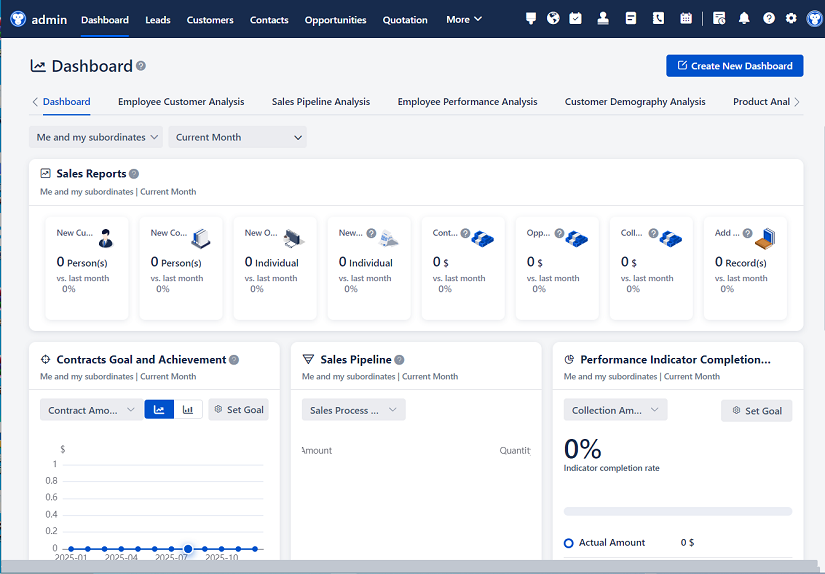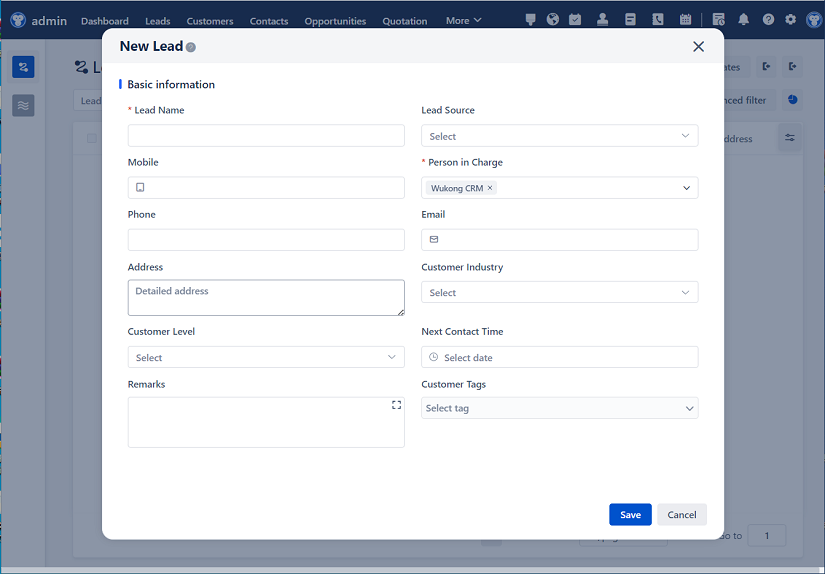
△Click on the top right corner to try Wukong CRM for free
You know, I’ve been thinking a lot lately about how businesses communicate with their customers. It’s wild how much has changed over the years, especially when it comes to customer relationship management. Like, remember when sales teams had to manually dial every single number, keep track of notes on paper, and then somehow remember who said what during a call? Yeah, that sounds exhausting — and honestly, kind of outdated.

Well, here’s something that’s been making a real difference lately: the Integrated Telephone Outbound Calling and CRM Management System. Honestly, it’s kind of a game-changer. I mean, think about it — what if you could make outbound calls directly from your CRM, log the conversation automatically, and have all that data instantly available for follow-ups or team collaboration? Sounds like a dream, right? But it’s not. It’s real, and it’s already helping companies work smarter.
Let me break it down for you. So, this system basically connects your phone system — whether it’s VoIP, landline, or mobile — directly into your CRM platform. That means no more switching between apps, no more forgetting to update records after a call. Everything happens in one place. You click a button, the call dials out, and as soon as you hang up, the system logs the call, records the duration, and even lets you add notes or tags right then and there.
And get this — some of these systems even use AI to transcribe the conversation in real time. So, if you’re on a call with a potential client and they mention they’re interested in a specific product feature, the system can pick that up and flag it automatically. No more scrambling to remember what was said. It’s like having a personal assistant who never misses a detail.
I’ve talked to a few sales managers who’ve implemented this kind of system, and they all say the same thing: their teams are way more productive now. One guy told me his team used to spend almost half their day just on administrative tasks — logging calls, updating statuses, sending follow-up emails. Now? That time’s cut down to maybe 10 minutes. The rest? They’re actually talking to customers.
And it’s not just about saving time. It’s about accuracy, too. You know how easy it is to forget a detail or mix up two clients when you’re juggling a dozen calls a day? With this system, every interaction is recorded and stored exactly where it should be — in the client’s CRM profile. So the next time someone on the team reaches out, they’re not starting from scratch. They can see the whole history: past calls, emails, notes, even the tone of previous conversations.
Another thing I really like is how it helps with training and coaching. Managers can listen to recorded calls, give feedback, and even use real examples to train new hires. It’s way more effective than just saying, “Here’s how we do things.” Now they can say, “Here’s how we actually did it — and here’s how we can improve.”
Oh, and let’s not forget about compliance. In industries like finance or healthcare, keeping accurate records of customer interactions isn’t just helpful — it’s required. This system makes it so much easier to stay compliant. Every call is timestamped, logged, and stored securely. No more worrying about missing documentation during an audit.

But here’s the thing — it’s not just for big companies. Small businesses and startups are using this too. In fact, some of the most innovative implementations I’ve seen are from smaller teams who really lean into the automation side of things. One startup I spoke with uses the system to automatically schedule follow-up calls based on how the previous conversation went. If a lead showed strong interest, the system books a call with a senior sales rep the next day. If they were hesitant, it triggers a nurturing email sequence instead.
And the best part? A lot of these systems are surprisingly easy to set up. Most of them integrate with popular CRM platforms like Salesforce, HubSpot, or Zoho. You don’t need a team of IT specialists to get it running. In many cases, it’s just a matter of connecting your phone service, syncing your CRM, and training your team on the new workflow.
Of course, it’s not perfect. Like any tech, there can be hiccups. Sometimes the voice recognition isn’t 100% accurate, especially with strong accents or noisy environments. And not every CRM plays nicely with every phone system — though that’s getting better as more providers build open APIs.
But honestly, the benefits far outweigh the drawbacks. Think about the customer experience. When a rep calls you and already knows your name, your past purchases, and even the last issue you called about — that feels good, right? It shows you’re not just another number. And that kind of personal touch? That’s what builds loyalty.
I also love how this system helps with data-driven decisions. Because everything is tracked, managers can see things like: Which reps have the highest conversion rates? What time of day do most calls result in sales? Which scripts are working — and which ones aren’t? That kind of insight used to take weeks of manual reporting. Now it’s available in real time with just a few clicks.
And let’s talk about scalability. When a company grows, communication often breaks down. New hires don’t have context, teams get siloed, and customers end up repeating themselves. But with an integrated system, growth becomes smoother. Onboarding is faster because new team members have full access to historical data. Collaboration improves because everyone’s working from the same playbook.
One thing I’ve noticed is that teams using this system tend to be more motivated. Why? Because they’re spending less time on busywork and more time doing what they actually enjoy — talking to people and closing deals. One sales rep told me, “I used to dread making cold calls because of all the paperwork after. Now, I actually look forward to them. The system handles the boring stuff, so I can focus on the conversation.”
And it’s not just sales. Customer support teams are using it too. Imagine a support agent who can see not only your past tickets but also the last time you spoke with a sales rep — and what was discussed. That context changes everything. It means they can resolve issues faster and with more empathy.
Another cool feature? Predictive dialing. Some systems can automatically dial the next number on your list, but only connect the call when a rep is available. That eliminates dead time between calls and keeps the team moving. And because it’s integrated with the CRM, each call is still logged properly — no manual entry needed.
I’ve even seen companies use this for market research. They’ll run outbound campaigns to gather feedback, and the system automatically categorizes responses based on keywords. So if ten customers mention “slow shipping,” that gets flagged as a trend. That kind of real-time feedback is gold.
Now, I know what some of you might be thinking: “Isn’t this kind of system expensive?” And yeah, some enterprise-level solutions can be pricey. But there are affordable options out there — especially for small to mid-sized businesses. And when you consider the time saved, the increase in conversions, and the reduction in errors, the ROI usually pays for itself within months.
Security is another concern people have. And rightfully so. You’re dealing with sensitive customer data and voice recordings. But most reputable systems use end-to-end encryption, role-based access controls, and comply with regulations like GDPR and CCPA. As long as you choose a trusted provider and follow best practices, your data should be safe.
And let’s not forget about mobile access. A lot of these systems have mobile apps, so your team can make calls and update records from anywhere. That’s huge for remote teams or reps who are always on the go. They don’t need to be at their desk to stay productive.
Honestly, I think we’re just scratching the surface of what’s possible. As AI gets smarter, these systems will get even better at things like sentiment analysis — figuring out if a customer is happy, frustrated, or indifferent based on their tone. That could help route calls to the right agent or even suggest talking points in real time.
Some systems are already experimenting with voice bots that handle simple inquiries, freeing up human agents for more complex issues. And when a call does get transferred to a person, the bot can summarize the conversation so far. No more “Can you repeat that?” moments.
At the end of the day, this isn’t just about technology. It’s about people. It’s about making life easier for your team so they can focus on building real relationships with customers. Because no matter how advanced the system gets, human connection is still the heart of any business.
So if you’re still making outbound calls the old-fashioned way — bouncing between apps, forgetting to log notes, missing follow-ups — it might be time to take a look at an integrated telephone and CRM system. It’s not just a tool. It’s a way to work smarter, sell better, and treat your customers like the individuals they are.
And hey, if you’re curious about how it all works in practice, here are a few questions I’ve heard people ask — along with some honest answers.
Q: Can this system work with our existing phone setup?
A: Most likely, yes. Many integrated systems support VoIP, traditional landlines, and even mobile numbers. It really depends on your provider, but compatibility is usually pretty broad.
Q: Will my team need a lot of training to use it?
A: Not really. Most systems are designed to be intuitive. If your team already uses a CRM, the learning curve is usually pretty gentle. Plus, most vendors offer onboarding support.

Q: What if we have poor internet connection?
A: That can be a challenge, especially for VoIP-based systems. But many platforms have offline modes or fallback options. It’s worth testing in your environment before going all-in.
Q: Can we customize the workflows?
A: Absolutely. One of the big advantages is that you can tailor the system to your sales or support process — from call scripts to follow-up triggers.
Q: Is it hard to migrate data from our old system?
A: It depends on what you’re migrating from. Most CRM platforms have import tools, and many providers offer migration assistance. It’s usually smoother than people expect.
Q: Does it work for inbound calls too?
A: Yes! While the focus here was on outbound calling, most of these systems handle inbound calls just as well — with automatic logging and screen pops based on caller ID.

Q: Can we try it before committing?
A: Definitely. Most vendors offer free trials or demos. It’s a great way to see how it fits with your team’s workflow before making a decision.
Related links:
Free trial of CRM
Understand CRM software
AI CRM Systems

△Click on the top right corner to try Wukong CRM for free